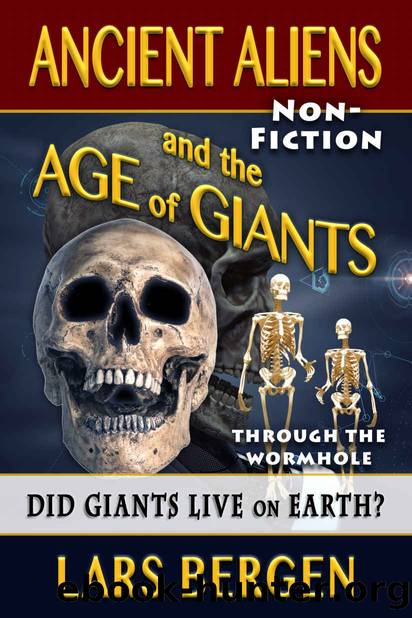Ancient Aliens and the Age of Giants: Through the Wormhole by Lars Bergen & Sharon Delarose

Author:Lars Bergen & Sharon Delarose [Bergen, Lars]
Language: eng
Format: azw3
Publisher: Gityasome Books
Published: 2014-07-01T00:00:00+00:00
In other words, translators will filter the inscription through their own personal beliefs. One sees a biblical message, while another sees a weary traveler, or a Welsh prince, or a Cherokee message. By the same token, giant bones are either singular instances of people with abnormal growth, or they represent a race of giants that roamed the world prior to, and alongside, modern humans. The opinion given will match the preconceived beliefs of the person making the statement.
Today, the Bat Creek Stone controversy rages on â still embroiled in allegations of fraud, hoaxes, and finger pointing. If archeologists and other experts cannot agree with one another, how on earth can we ever know the truth behind a single artefact, or discovery of bones? Especially when evidence vanishes, such as ancient skeletons or field notes?
Another important point is that several archeologists, studying the same site, the same giant bones, and the same artifacts, will present different opinions. They do not agree amongst themselves, so when you use an expert opinion as a basis for your own opinion, keep that in mind.
Coincidentally, there was a Native American tribe known as the Modocs, who were driven out by gold miners. Joaquin Miller wrote a book in 1874 entitled, Unwritten History: Life Amongst the Modocs. The Bat Creek inscription was found in Tennessee, while the Modocs lived in the western states. His book was not well-embraced as it portrayed life from the point of view of the Modocs, rather than their oppressors.
The Modocs shared a valley with the Paiute, and they had a village on Tule Lake. Remember the red-headed Si-Te-Cah giants of Paiute legend who were called Tule Eaters, who lived on a raft in a lake? The Modocs also had legends of a red-headed tormenter that they called Yahyáhaäs, minus the raft.
They didn't call him a giant, but he was tall and naked with a great head of bushy, bright red hair. He could put you into such a deep sleep, that it appeared as if you were dead. He also cut off the fingers of living people, and wore the fingers on a necklace around his neck. He stole men's wives, and he could disappear "like a flash." He carried a cane that emitted a "streak of fire."
The name of this frightening man whose power seemed almost magical was Yahyáhaäs. Compare that to the giant Nephilim brothers from the Book of Giants: Ohyah and Ahyah or Hahyah. These Nephilim brothers were connected to the Grigori, and to the Yaksas who begot the giants who brought ruin to Earth and its humans. This is yet another one of those odd coincidences where entities on opposite sides of the globe share similar names, like the Quiname and Quimane giants. And speaking of coincidences, is there any connection between the inscription that mentions a Madoc ruler, and the Modocs?
As for the necklace of fingers, this is not unprecedented. The Smithsonian's Ninth Annual Report of the Bureau of Ethnology highlighted two finger-necklaces as worn by
Download
This site does not store any files on its server. We only index and link to content provided by other sites. Please contact the content providers to delete copyright contents if any and email us, we'll remove relevant links or contents immediately.
| Aeronautics & Astronautics | Astronomy |
| Astrophysics & Space Science | Comets, Meteors & Asteroids |
| Cosmology | Mars |
| Solar System | Star-Gazing |
| Telescopes | UFOs |
Tools of Titans by Timothy Ferriss(8306)
Turbulence by E. J. Noyes(7981)
Secrets of Antigravity Propulsion: Tesla, UFOs, and Classified Aerospace Technology by Ph.D. Paul A. Laviolette(5335)
Astrophysics for People in a Hurry by Neil DeGrasse Tyson(5152)
Room 212 by Kate Stewart(5073)
Design of Trajectory Optimization Approach for Space Maneuver Vehicle Skip Entry Problems by Runqi Chai & Al Savvaris & Antonios Tsourdos & Senchun Chai(5039)
Pale Blue Dot by Carl Sagan(4960)
The David Icke Guide to the Global Conspiracy (and how to end it) by David Icke(4658)
A Journey Through Divination and Astronomy by Publishing Pottermore(4364)
Goodbye Paradise(3763)
Apollo 8 by Jeffrey Kluger(3669)
COSMOS by Carl Sagan(3590)
The Five People You Meet in Heaven by Mitch Albom(3521)
Losing the Nobel Prize by Brian Keating(3519)
How to Read Water: Clues and Patterns from Puddles to the Sea (Natural Navigation) by Tristan Gooley(3434)
Brief Answers to the Big Questions by Stephen Hawking(3394)
How to Read Nature by Tristan Gooley(3294)
The Order of Time by Carlo Rovelli(3163)
A Brief History of Time by Stephen Hawking(2994)
